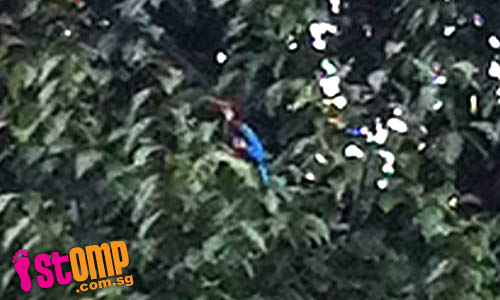
Showing posts with label Bukit Batok. Show all posts
Showing posts with label Bukit Batok. Show all posts
Wednesday, June 13, 2012
Thursday, August 4, 2011
Wednesday, May 12, 2010
Fallen tree crushes car at Bukit Batok after storm
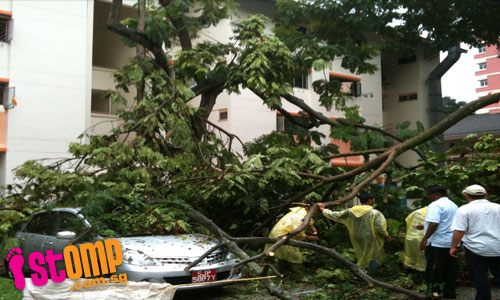
This car, parked at Bukit Batok East Avenue 4, was crushed by a tree after a thunderstorm yesterday (May 11).
STOMPer tititatitu said:
"This happened around 5.30 pm on Tuesday evening after the thunderstorm.
"It's at the open car park at Bukit Batok East Avenue 4.
"No one was hurt."
Labels:
Bukit Batok,
falling trees,
STOMP
Monday, April 12, 2010
Palm tree flowers attract bees and pose danger to passers-by
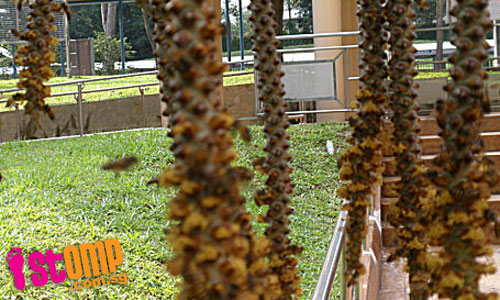
The flowers on this palm tree attract bees which pose a danger to passers-by walking to the bus stop nearby.
STOMPer apiphobic, who was stung by a bee, says:
"These pictures were taken near the bus stop beside Blk 288D at Bt Batok East Ave 6.
"As I was walking to the bus stop I felt a sharp piercing pain on my neck.
"When I rubbed my neck, I found a struggling bee.
"This palm tree near the bus stop bears flowers twice a year and during the flowering season, swarms of bees are attracted to the flowers.
"I hope the Town Council will not plant such trees in housing estates as they attract bees.
"Now, I have to take another route to reach the bus stop."

Oh right, so in that case, let's eliminate all flowering plants from our neighbourhoods.
I can accept the fact that most people may not be comfortable living in close proximity to stinging insects such as bees and wasps, especially if one is allergic to stings. However, calling for the palm trees to be cleared just because a single bee stung you is frankly preposterous.
Oh wait, is it the work of this person yet again?

Right. So far, he's self-diagnosed as being nyctophobic (afraid of the dark), ophidiophobic (afraid of snakes), arachnophobic (afraid of spiders), scoleciphobic (afraid of worms), and now he says he has a phobia of bees.
I know that there's a possibility that these are not all posted by the same person, but if you look at all these submissions, you will probably notice that all these posts have the same writing style.
Instead of kicking up such a big fuss because of his many irrational phobias, I think what this person needs is psychiatric help.
Labels:
arthropods,
Bukit Batok,
paranoia,
STOMP,
stupidity,
threats,
urban wildlife
Saturday, March 20, 2010
Overgrown mango tree makes me tremble whenever I cross overhead bridge

STOMPer Timid heart trembles whenever he crosses this overhead bridge near Block 288D Bukit Batok East Ave 6 because he thinks that unknown insects might be lurking in this mango tree's branches.
The STOMPer wrote in an email to STOMP:
"Whenever I cross this bridge, I have an ominous feeling that some spiders, worms, caterpillars or snakes might be lurking in the branches.
"The branches of this mango tree have grown until they touch the railings and this compounds my fear of creepy crawling insects.
"From young I have been arachnophobic, scoleciphobic and ophidiophobic and I hope LTA will send its workers to cut off these protruding branches."
My sympathies to those who genuinely suffer from phobias that prevent them from functioning in our society, but this is just ridiculous.
Labels:
Bukit Batok,
STOMP,
stupidity,
threats,
trees
Wednesday, December 30, 2009
Does anyone know what this strange insect is?

STOMPer Botanist chanced upon this queer looking insect during his walk at the Bukit Batok Nature Park and wonders if anybody can enlighten him on what it is.
In his email to us today (Dec 30), the STOMPer describes the insect:
"It has a green and brown body with stripes of yellow and black around the edges.
"It also has two conspicuous eyes and a pair of antennaes.
"I wonder if any STOMPer can identify this insect as I am not an entomologist?"
It's a species of shield bug (Pentatomoidea), although I'm unable to identify the exact species shown in the photo.
Shield bugs are commonly known as stink bugs, as many species are known to exude a foul-smelling liquid when disturbed, probably as a means of deterring predators.
Labels:
arthropods,
Bukit Batok,
STOMP
Sunday, December 6, 2009
Rare bird comes to Bukit Batok kopitiam

STOMPer Ornithologist was surprised to see this laughing thrush at a Bukit Batok coffee shop as it is rarely seen in urban areas. He says:
"These pictures were taken at a coffee shop at Blk 289H, at Bt Batok St 25.
"Last week I was sipping my coffee at the shop when I spotted this white-crested laughing thrush (Garrulax leucolophus) perched on a metal railing.
"Being a friendly bird it jumped onto the table and was eyeing my bread and coffee.
"I usually see this bird in the nature parks but this was the first time I see it at a coffee shop.
"The laughing thrush is a colourful and musical bird.
"Its usual habitat is the dense forest abundant with bamboo and it feeds mainly on fruit, insects and nectar."



The white-crested laughingthrush is not native to Singapore; while it ranges from the Himalayas to southern China and much of mainland Southeast Asia, it is absent from peninsular Thailand and the Malay Peninsula. The population in Singapore originated from escaped and released pets, and was first recorded in the late 1980s in Bukit Batok Nature Park. This species is now considered to be a common introduced resident throughout mainland Singapore. I myself have seen white-crested laughingthrush in the Kent Ridge area, and just last Sunday, I had the pleasure of watching a trio of these birds foraging next to a stream in the Bukit Timah Nature Reserve.

This is an audio recording of white-crested laughingthrush in Cambodia. Listen up for the calls of this bird, especially if you are in Bukit Batok, Bukit Timah, or Southern Ridges.
(Taken from xeno-canto Asia)

Bukit Batok;
(Photo by myrontay)

The birds in Singapore belong to the subspecies diardi, which is native to much of Thailand, Indochina and south China.
Phutthamonthon, Thailand;
(Photo by somchai@2008)

Nominate subspecies (Garrulax leucolophus leucolophus), Ramnagar, India;
(Photo by Abhishek unplugged!)
Interestingly enough, a great proportion of the images of this species on Flickr and the Oriental Bird Club Image Database were taken in Singapore; only a small handful of photos were taken within countries like India and Thailand. This either goes to show that there is a large proportion of tech-savvy photographers in Singapore compared to other countries, or that the white-crested laughingthrush is more easily encountered here than within its native range.
Laughingthrushes are a large group of birds found throughout much of tropical and warm temperate Asia, with the greatest diversity found in the Himalayas and southern China. The Wikipedia page currently lists 64 species, and more species are constantly being described and named. Traditionally, they form a single genus (Garrulax) belonging to the babbler family (F. Timaliidae). However, genetic research has revealed that many species usually thought of as babblers do not actually belong to this family, and are more closely related to other passerine families, making the Timaliidae a paraphyletic group; under some classification schemes, laughingthrushes themselves are split off as a separate family of their own, the Garrulacidae. Even Garrulax itself is a polyphyletic assemblage, and some have proposed splitting it into as many as 11 distinct genera. The Wikipedia pages on laughingthrushes and babblers contain more details and references. Basically, the systematics of passerine birds is a horrible mess.
Another non-native species of laughingthrush is found in Singapore, the Chinese Hwamei (Leucodioptron canorum, formerly Garrulax canorus). Like the white-crested laughingthrush, this native of China, Vietnam and Laos entered Singapore via the caged songbird trade, and was first recorded locally in the 1980s from many locations, including the islands of Sentosa, St. John's Island and Pulau Ubin.

Hong Kong;
(Photo by neilfif11)
However, the Chinese hwamei does not seem to have established itself as well as the white-crested laughingthrush. Since the 1990s, this species has been in sharp decline; the last mainland sighting was at Poyan in 1997, and the only extant population now lingers on in Sentosa. However, this same species has done very well in Hawaii, where it was introduced in the early 20th century.
A third species of laughingthrush, the greater necklaced laughingthrush (Garrulax pectoralis), has also been recorded in Singapore. Like the white-crested laughingthrush, this species is native to the Himalayas, southern China, and parts of Thailand and Indochina.

Kaeng Krachan, Thailand;
(Photo by somchai@2008)
Like the previous 2 species, the greater necklaced laughingthrush was first recorded in the 1980s, and since then, there have been sightings at Mount Faber, Kent Ridge, and Telok Blangah. While breeding has been reported, this species remains an uncommon escapee.
The fourth and final species of laughingthrush recorded in Singapore is the black-throated laughingthrush (Dryonastes chinensis, formerly Garrulax chinensis), native to southern China and parts of Indochina.
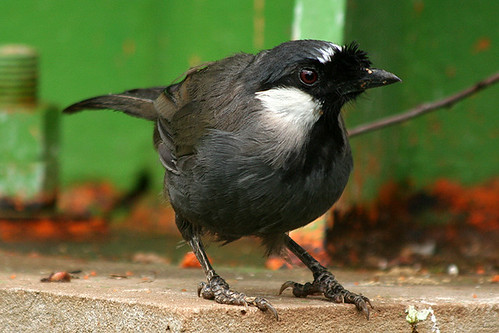
Kunming, China;
(Photo by iamtonyang)
There have been only a small handful of sightings of this species; the first record was at Upper Seletar Reservoir in 1989, 2 were spotted at Kent Ridge in 1993, 3 were seen at Telok Blangah in 1998, and a solitary individual was reported at Mount Faber in 2003.
The laughingthrushes are just 4 out of a long list of non-native bird species that have been recorded here in Singapore. It is interesting that the white-crested laughingthrush has managed to flourish quite well, unlike the Chinese hwamei. The very different fates of these 2 species are just 2 possible scenarios that can be played out when an exotic species is introduced to a new location, whether deliberately or by accident. Most eventually die out, being unable to adapt to the new environment, or have had little success at finding suitable mates and reproducing; it is likely that the black-throated laughingthrush falls within this category.
Some species do manage to reproduce, but for some reason, are unable to form a self-sustaining population; in such cases, the population is either supplemented by new releases and escapees, or numbers eventually peter and die out. It is probable that even without human intervention, the Chinese hwamei will eventually become extinct locally.
Then there are others that not only manage to establish breeding populations, but become common elements in their new habitats, like the white-crested laughingthrush.
I won't be surprised if the white-crested laughingthrush presents competition for resources that some of our more threatened native species could do without. However, unlike other non-native birds such as Javan myna (Acridotheres javanicus), feral pigeon (Columba livia), or house crow (Corvus splendens), the white-crested laughingthrush is regarded as a benign presence, and so far, it is not thought to present any threat to the survival of native birds.
Labels:
birds,
Bukit Batok,
introduced species,
pets,
STOMP,
urban wildlife
Thursday, October 8, 2009
Stop treating Little Guilin as a dumping ground!

STOMPer Mountaineer is upset that visitors have been treating Little Guilin as a dumping ground and throwing heaps of rubbish into the lake there.
In an email to STOMP today (Oct 8), the STOMPer says:
"These pictures were taken at Little Guilin at Bt Batok East Ave 5. The lake which was previously a disused granite quarry is a haven of peace for man and birds. On Sundays, hordes of anglers come here to pass the day. However, of late, the lake has become a dumping ground for many visitors.
"You can see plastic bottles, cups, metal cans, papers and dead leaves floating in the clear water.
"This is a famous lake where newlyweds come here on weekends to shoot their wedding photographs.
"I hope the residents in the vicinity will keep the lake clean and green so that our Little Guilin will become as well known as Sentosa or Genting Highlands."
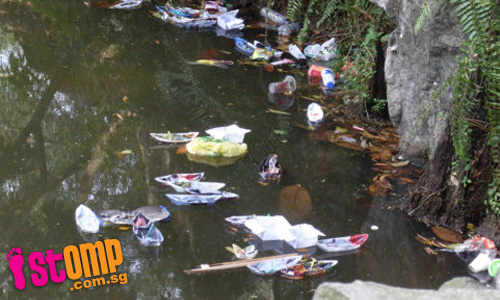

Labels:
Bukit Batok,
parks and gardens,
pollution,
STOMP,
stupidity,
threats
Sunday, October 4, 2009
Mooncake Festival revellers leave big mess at Little Guilin
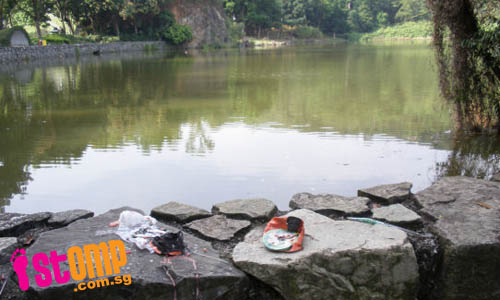
STOMPer Lu Xun was appalled at the state of Little Guilin the morning after Mooncake Festival celebrations were held there (Oct 3).
In an email today the STOMPer wrote:
"These pictures were taken at Little Guilin and the Bukit Batok Town Park at Bukit Batok East Avenue 5.
"There are two condos and some 20 HDB blocks in the vicinity. Last night was the 15th day of the 8th Lunar month and Chinese people here celebrated the Mooncake Festival or zhong qiu jie.
"When I visited the park this morning I was shocked by the aftermath of the celebrations.
"Parents have brought their kids to enjoy the lantern parade in the park but they left behind a big mess and it is a crying shame how our citizens treat their public parks and lakes."
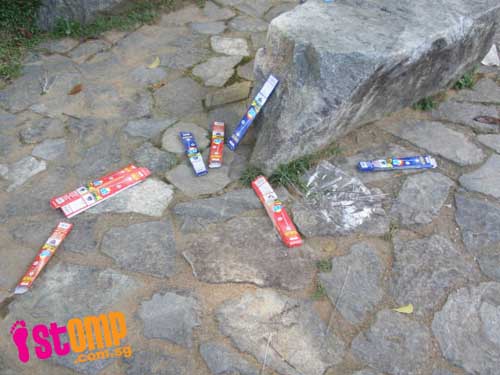
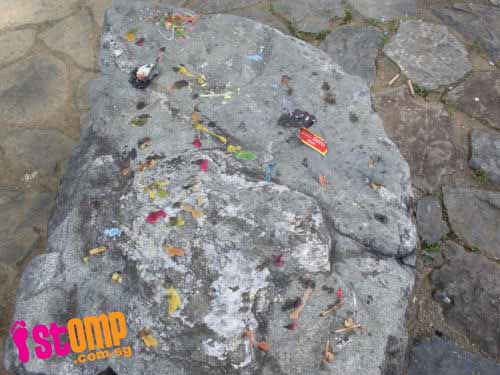

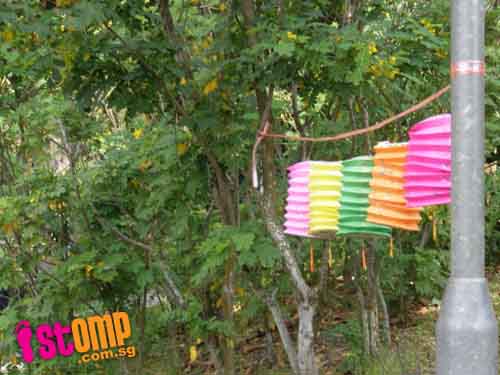
It really is one of life's biggest ironies, the way so many people will go to the trouble of visiting places of scenic beauty, only to ruin the environment with their callous and selfish actions.
Labels:
Bukit Batok,
pollution,
STOMP,
stupidity,
threats
Friday, August 28, 2009
Yellow poplar trees add colour to Bt Batok Nature Park

STOMPer Arborist spotted yellow poplar trees in Bukit Batok Nature Park, amongst other wonders of Nature, and shares them here on STOMP. He says:
"These pictures were taken at the Bukit Batok Nature Park.
"As I was jogging in the park one day I saw this tall tree with bright yellow leaves which reminded me of those yellow poplar trees (Liriodendron tulipifera) in the USA.
"Like the yellow poplar this tree grows to a height of about 80m.
"The famous yellow poplar tree bears cone-shaped fruits and they release winged seeds which are eaten by squirrels and beavers.
"The leaves usually turn yellow in autumn but in our tropical climate it is strange to see a tree with only yellow leaves in August.
"On the forest floor I found this bracket fungus (Ganoderma sp).
"This fungus usually attacks timber trees causing wood decay.
"The beautiful lake in the nature park was once a granite quarry. It is now a fresh water lake teeming with fish and tortoises."



If the trees look like yellow poplar but aren't actually yellow poplar, then aren't the title and the introductory paragraph a little misleading?
The yellow poplar, also known as the American tulip tree or tulip poplar, is native to the forests of eastern North America, although it has been introduced to many temperate parts of the world.
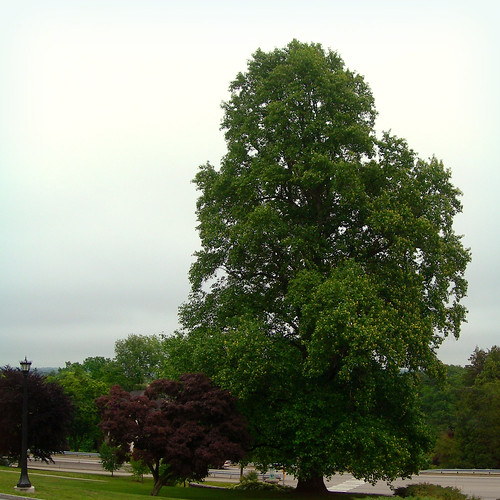
American tulip tree on Connecticut College;
(Photo by Seaweed Lady)
Despite its common name, it is not at all closely related to the poplars (Populus spp.). Its closest living relative is the Chinese tulip tree (Liriodendron chinense), which is found in many parts of central and southern China.
The American tulip tree is the tallest hardwood that can be found in the eastern forests.
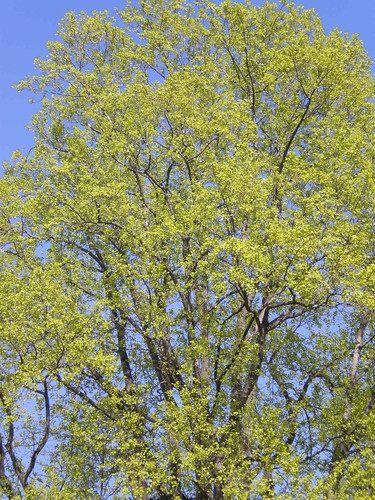
(Photo by Joel Abroad)

It also has very distinctive leaves.
(Photo by lucycat)

Its flowers bear a very close resemblance to tulips, hence its common name.
(Photo by William_Tanneberge r)

It produces large numbers of winged seeds, which are then dispersed by the wind.
(Photo by ophis)
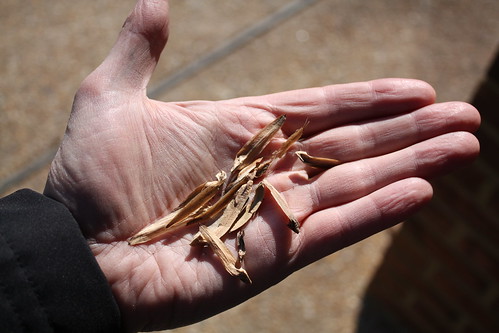
(Photo by claytonsnatives)
I have no idea which species of tree is represented in the original post on STOMP, although I am quite sure that it is not an American tulip tree.
Another thing that I am quite sure of is that you won't find any tortoises swimming in the lake; I see this person still hasn't learned anything about the differences between turtles and tortoises, which are wholly terrestrial.
Labels:
Bukit Batok,
parks and gardens,
STOMP,
stupidity,
trees
Thursday, August 27, 2009
Bt Batok's botak trees: Pruned because residents complained about bird nuisance

Hong Kah Town Council says that the trees in a Bukit Batok carpark were pruned as residents had complained about the noise and droppings from the birds which perched on the trees.
This was in response to STOMPer Aborist's earlier post where he stated that the trees looked pathetic and wondered why all the leaves had been trimmed away.
In an email sent to STOMP(August 27), the Hong Kah Town Council says:
"Residents living in the blocks near the carpark at Blk 331, Bukit Batok St 33 had earlier sent feedback to our Town Council about both the noise nuisance and droppings from the birds perching on the trees.
"They requested for us to prune the trees to deter the birds from roosting.
"Pruning was thus carried out and this has greatly reduced the incidence of bird nuisance, thereby creating a more pleasant environment for the residents.
"We thank STOMPer Aborist for the opportunity to clarify matters."
Related story:
No point having trees in carpark if they are 'botak'
Related post: No point having trees in carpark if they are 'botak'
Labels:
Bukit Batok,
STOMP,
trees
Sunday, August 23, 2009
Pretty to look at, but watch out for sharp thorns on these plants

These plants planted next to a pedestrian walkway are covered with sharp thorns, says STOMPer Resident. Walk too close to them and you could be in for a painful experience.
Here's what the concerned STOMPer wrote in an email today (Aug 23):
"This picture was taken at the junction of Bukit Batok East Avenue 6 and Bukit Batok Street 22.
"Planted beside the walkway are some plants with very sharp thorns and if you are not careful these thorns can cause you a lot of pain and discomfort.
"Plants planted near public walkways should not be a hazard to pedestrians. I hope this plant can be removed."
Similar Stories:
Thorns from overgrown plant at corridor is nuisance to Tampines residents
'Thorns of this desert plant could hurt passers-by'
Related posts: Trees along Tampines park connector are safety hazards in disguise (17th June 2009)
This cactus plant at Kembangan is a danger to passersby (6th June 2009)
Sharp leaves are danger to residents and passersby (30th May 2009)
'Dangerous' plants removed from polyclinic grounds (14th April 2009)
Dangerous plants at polyclinic, says STOMPer (2nd April 2009)
Be careful the next time you're at Clarke Quay (12th March 2009)
Why plant chilli in area accessible by kids? (11th March 2009)
Dead leaves dangling from palm tree can crack your skull! (28th January 2009)
Labels:
Bukit Batok,
STOMP,
stupidity
Friday, August 21, 2009
No point having trees in carpark if they are 'botak'

STOMPer Aborist noticed that the trees in this Bukit Batok carpark have their leaves all trimmed away, and wonders what is the point of having 'botak' trees.
He says:
"These pictures were taken at the carpark at Blk 331, Bukit Batok St 33.
"As I was passing the car park I noticed that the trees were all 'botak' and they looked so pathetic.
"I understand there is a need to trim the trees if the branches are overgrown or when the crown blocks out the light from the street lamps.
"By all means trim the branches but why make them bald?
"Now in the afternoon the carpark is as hot as an oven."

Labels:
Bukit Batok,
STOMP,
trees
Monday, August 3, 2009
Appreciating nature relieves stress, says STOMPer
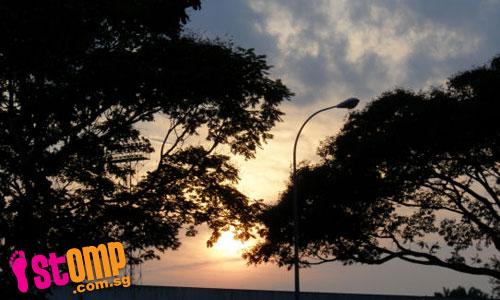
STOMPer Astronomer shares these sights of nature that he says bring him inner peace.
Says the STOMPer:
"These two pictures were taken at 6.30pm at Corporation Road near the Jurong Stadium.
"I saw an orange sky where the sun was setting and also the dark silhouette of trees and the tall tower of floodlights.
"The day was coming to an end and the birds were flying back to their nests.
"I was passing Bukit Batok St 25 at 7.00pm on the same day and I saw the blue sky and the white moon appearing above the trees.
"I have learnt to appreciate the beauty of nature and my life has become more peaceful."

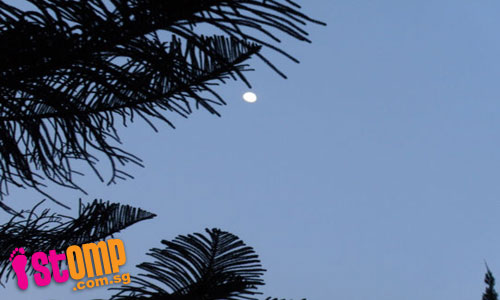
Labels:
Bukit Batok,
Jurong,
STOMP
Saturday, August 1, 2009
Rare White Bat Lily adds special touch to Bukit Batok park

A nature park tucked away in the heartlands of Bukit Batok is home to some rare flora species, says STOMPer Arborist, who spotted this rare and beautiful White Bat Lily there while on a visit.
The sender not only saw the flower at the Bukit Batok Nature Park, he also spotted a quarry lake and took many scenic pictures from the 80m cliff.
STOMPer Arborist says:
"These pictures were taken at the Bt Batok Nature Park at Bt Batok East Ave 2.
"This tree looks as if it is suffering from some skin disease as the bark is peeling off from the trunk.
"I saw the white bat lily (Tacca integrifolia), which grows well on mountain slopes in Cambodia, Malaysia and Singapore. It is the most unusual flowering plant as its weird flower arrangement is about 1m from top to bottom.
"Its top bracts consist of two spectacular dorsals usually white and purple stripes and each one about 20 cm wide.
"The true flowers are like thick purple buttons and there are huge purple whiskers which hang from the flowers to about 60cm below.
"The view of the quarry lake from a height of about 80m as I took this picture from a rain shelter near the top of the cliff. The lake teems with tortoises and monitor lizards.
"However, it was about 3pm in the afternoon and the street lamps in the park were brightly lit. This was a sheer waste of electricity."
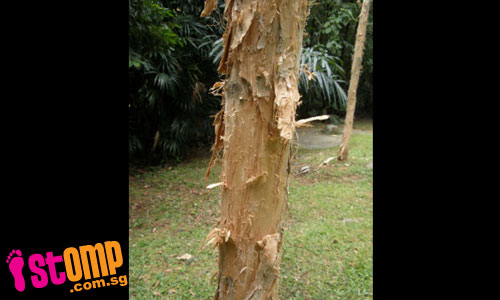
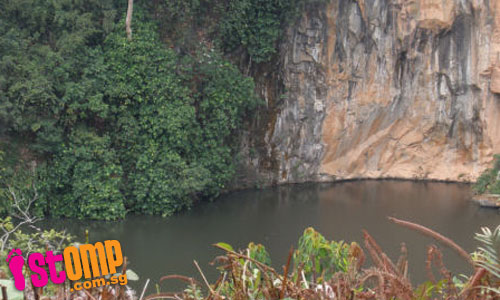

The bat lily (Tacca integrifolia) is adapted to growing in the shady understorey of forests, and can be spotted in our Central Nature Reserves, as well as in Bukit Batok Nature Park. It has a wide distribution throughout much of Southeast Asia.
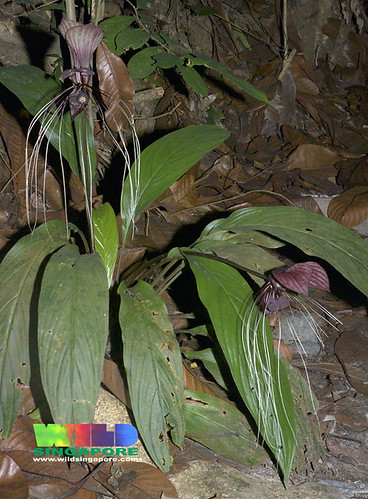
Bat lily, Bukit Timah Nature Reserve;
(Photo by Ria)
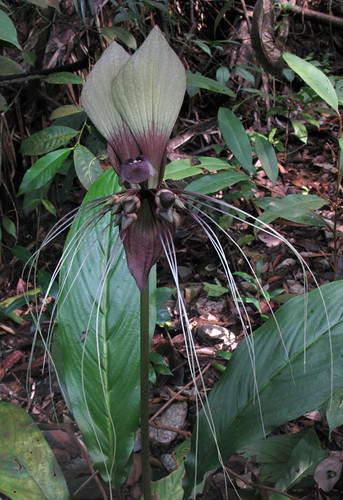
Bat lily, Bukit Timah Nature Reserve;
(Photo by Marcus)
If you have realised that the bat lilies in the above photo look somewhat different from the one posted on STOMP, it's because the one posted on STOMP appears to be the white bat lily, a form that was actually once considered to be a separate species known as Tacca nivea. However, it appears that it is actually a horticultural variety of the bat lily.

White bat lily, Wave Hill;
(Photo by suavemaeve)
A relative of the the bat lily that can also be found in Singapore is the seashore bat lily (Tacca leontopetaloides). This species grows in coastal forests.
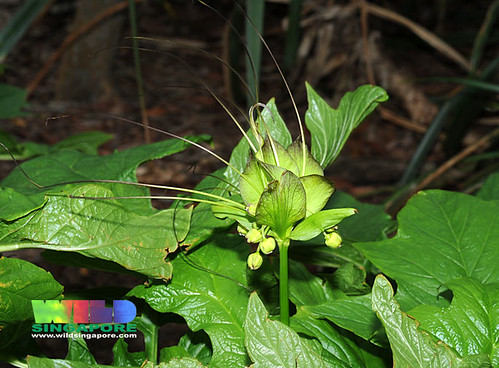
Seashore bat lily, Pulau Semakau;
(Photo by Ria)
This plant can be found over a large area, from coastal East Africa to Southeast Asia, Australia, and many islands of the Pacific. However, the seashore bat lily is considered critically endangered in Singapore, and is known to grow in a natural state only on Pulau Semakau and Pulau Pawai. Several plants have also been propagated in Bukit Batok Nature Park.
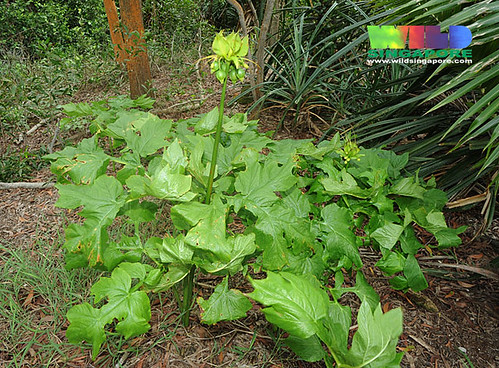
Seashore bat lily, Pulau Semakau;
(Photo by Ria)
Subscribe to:
Posts (Atom)
